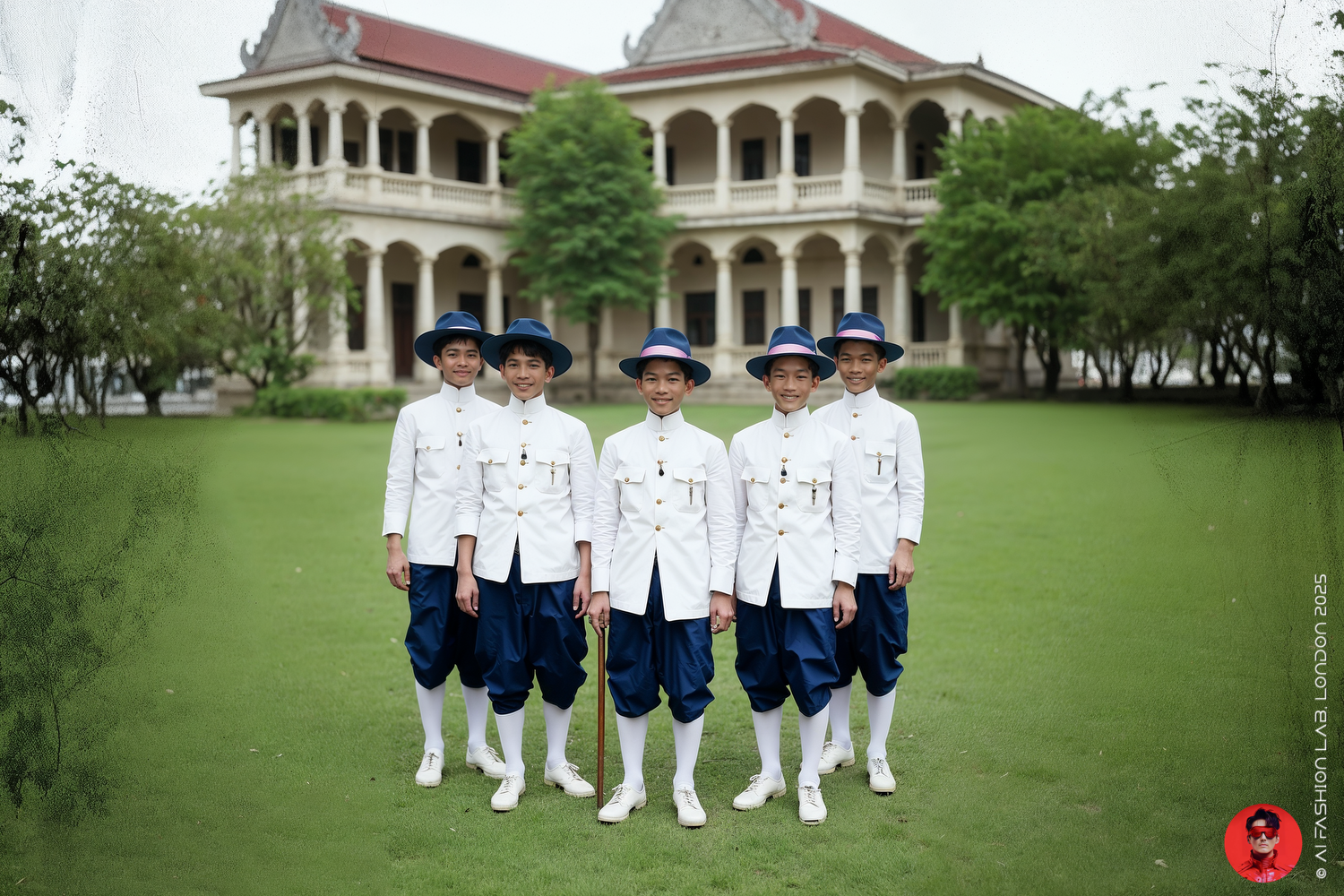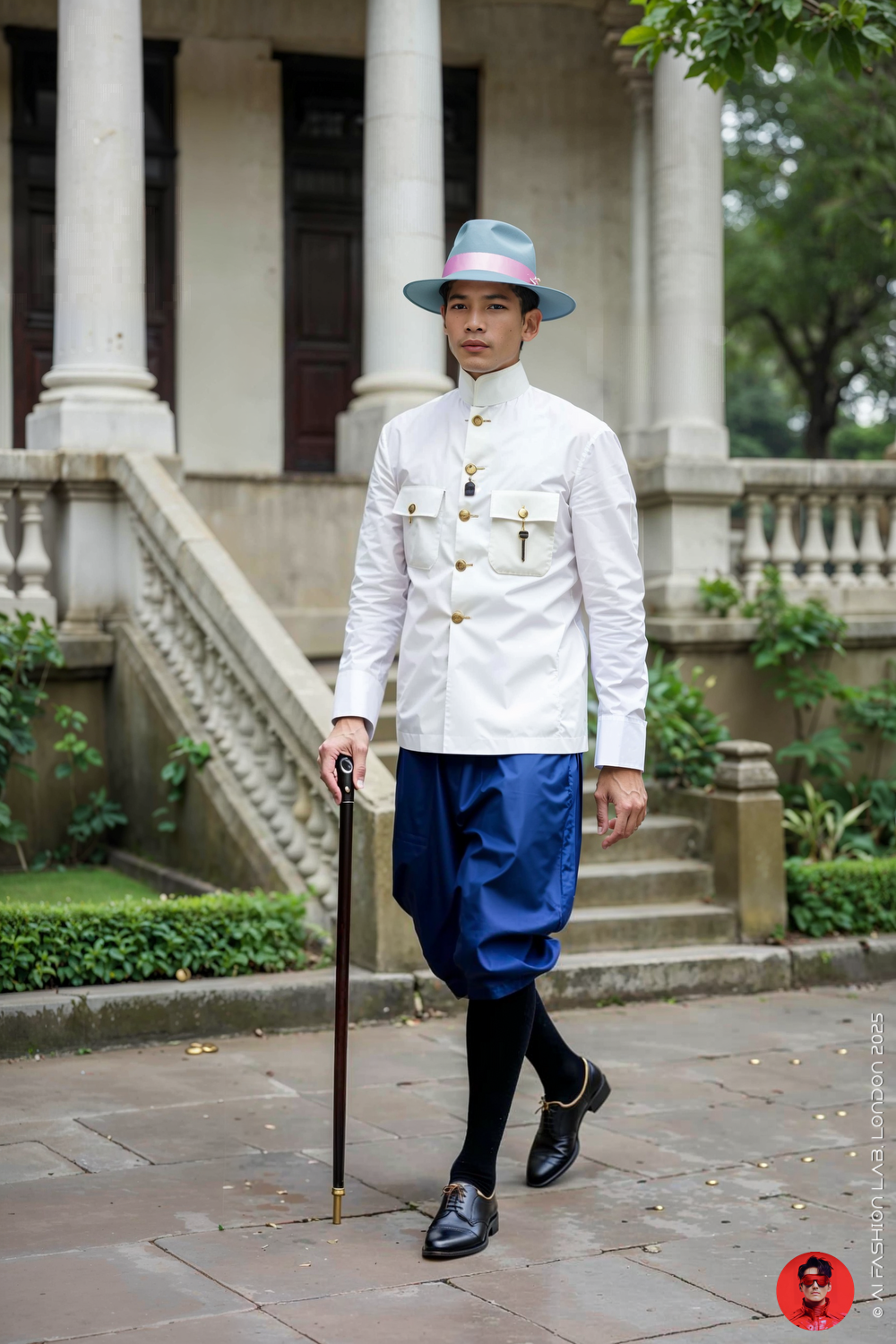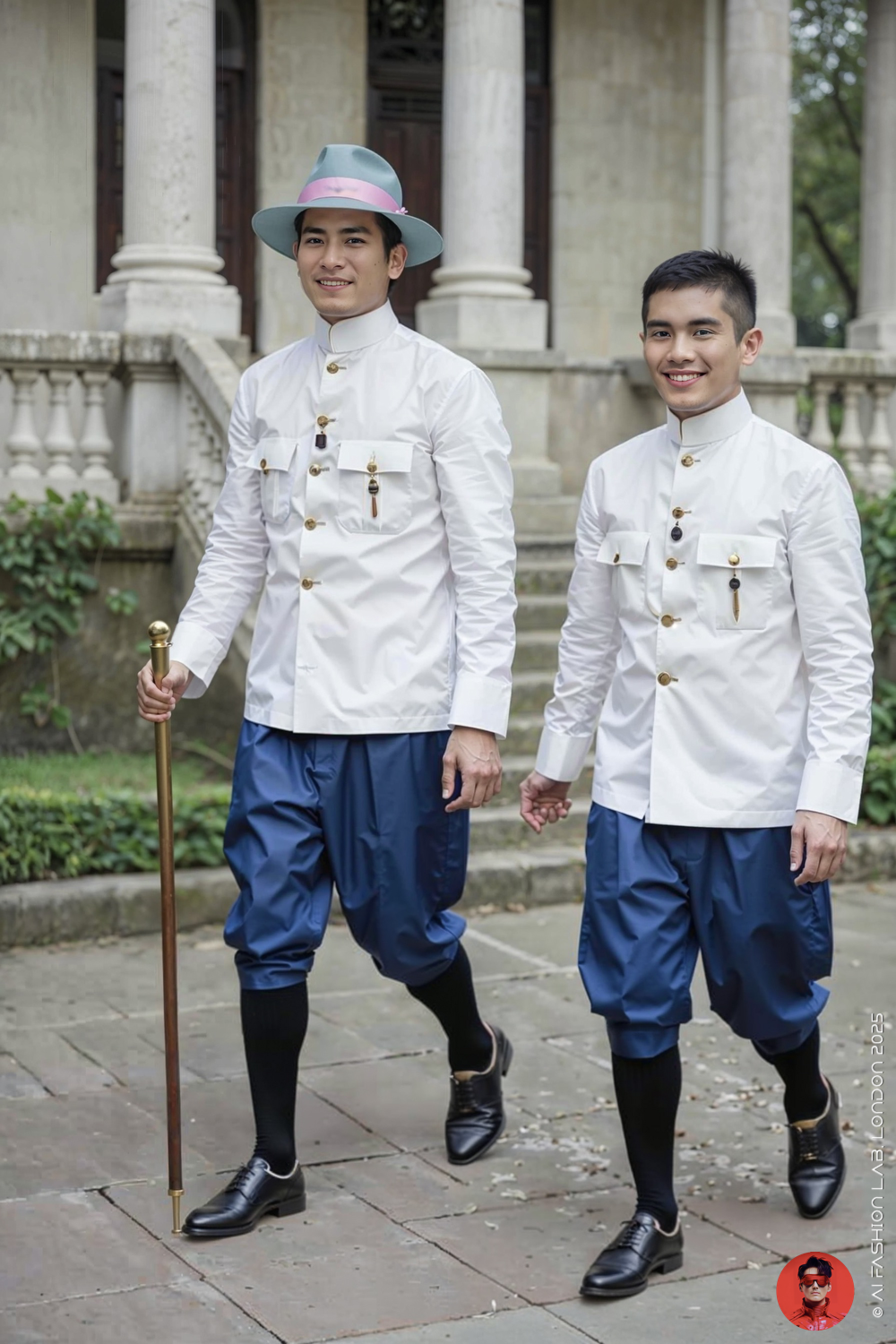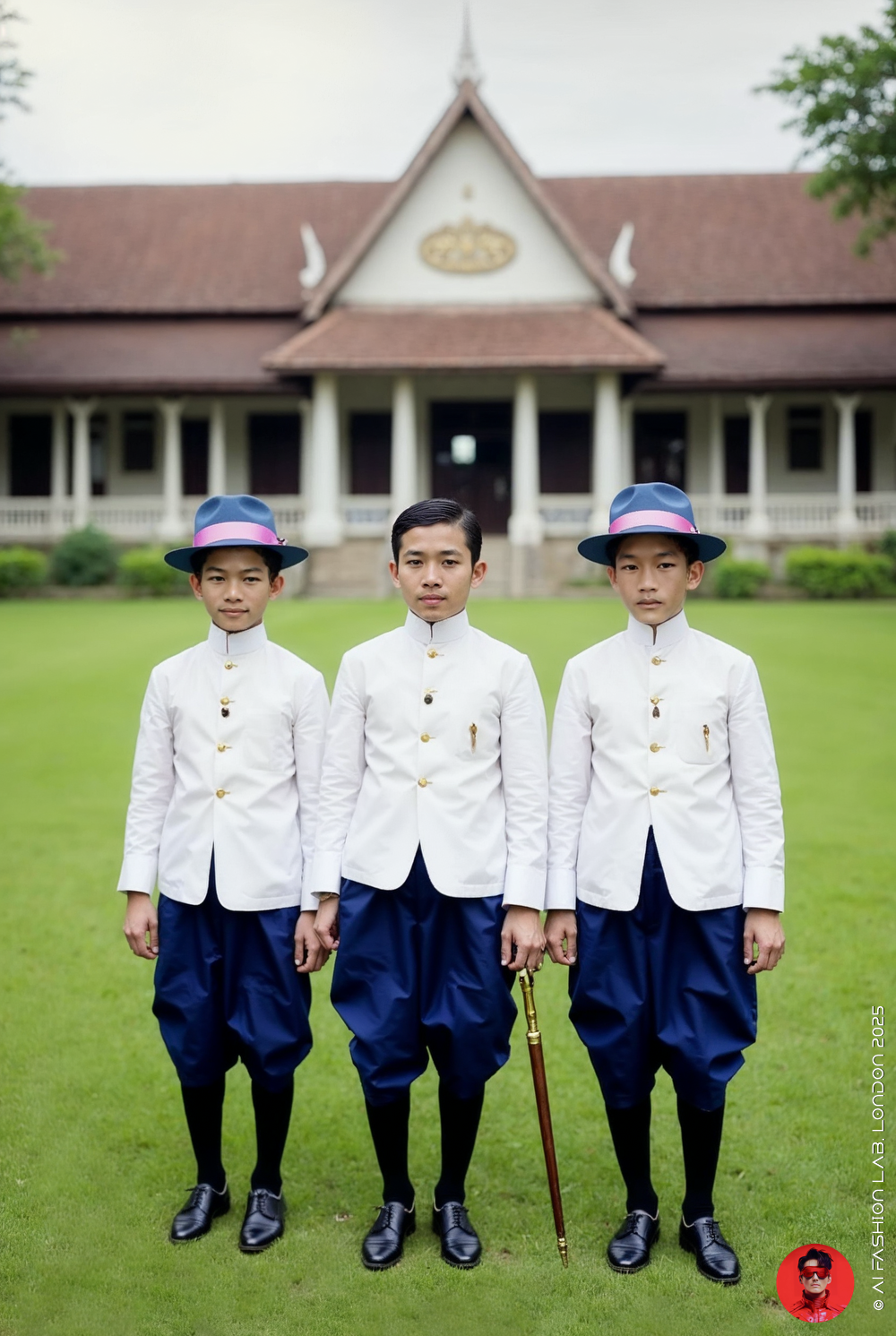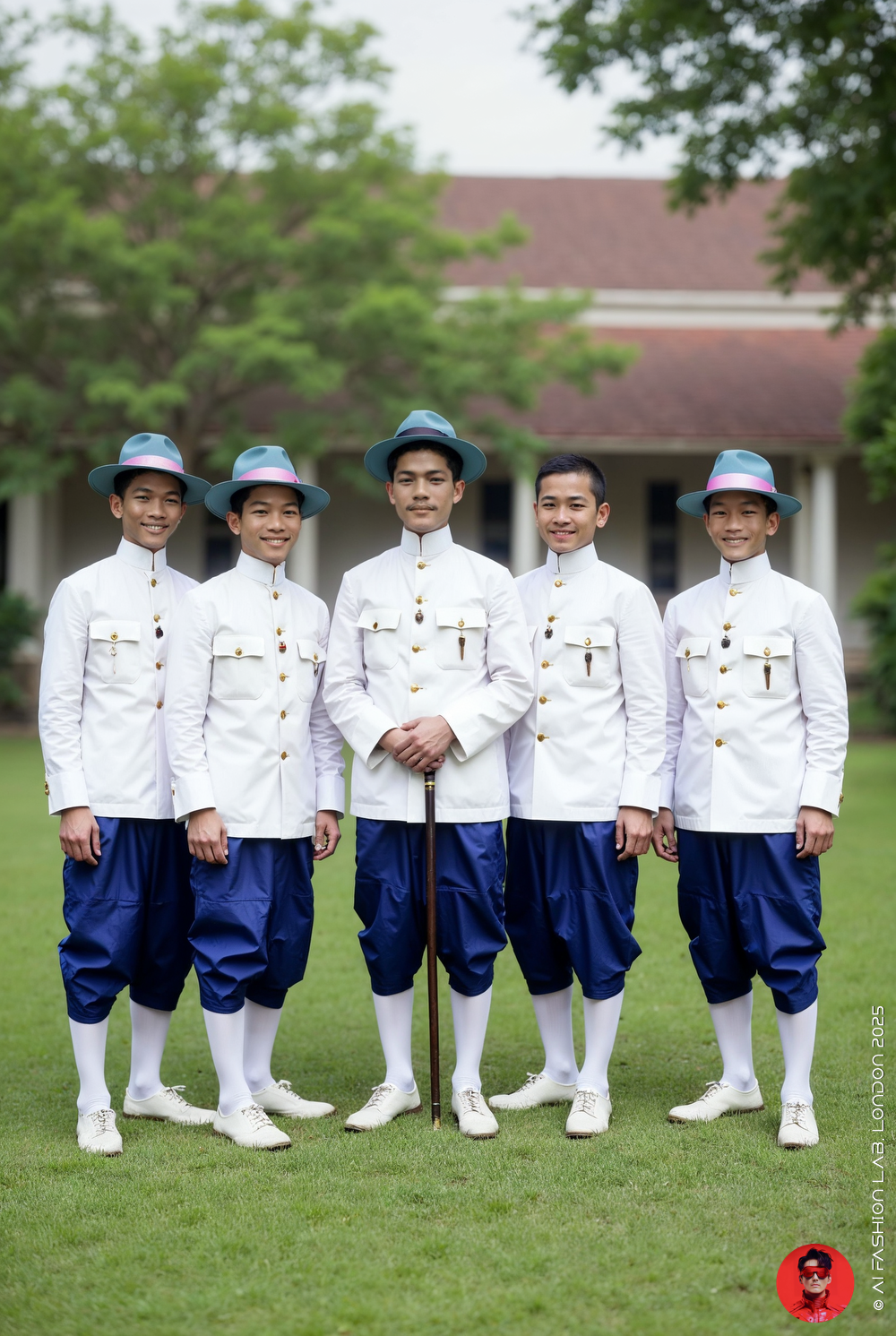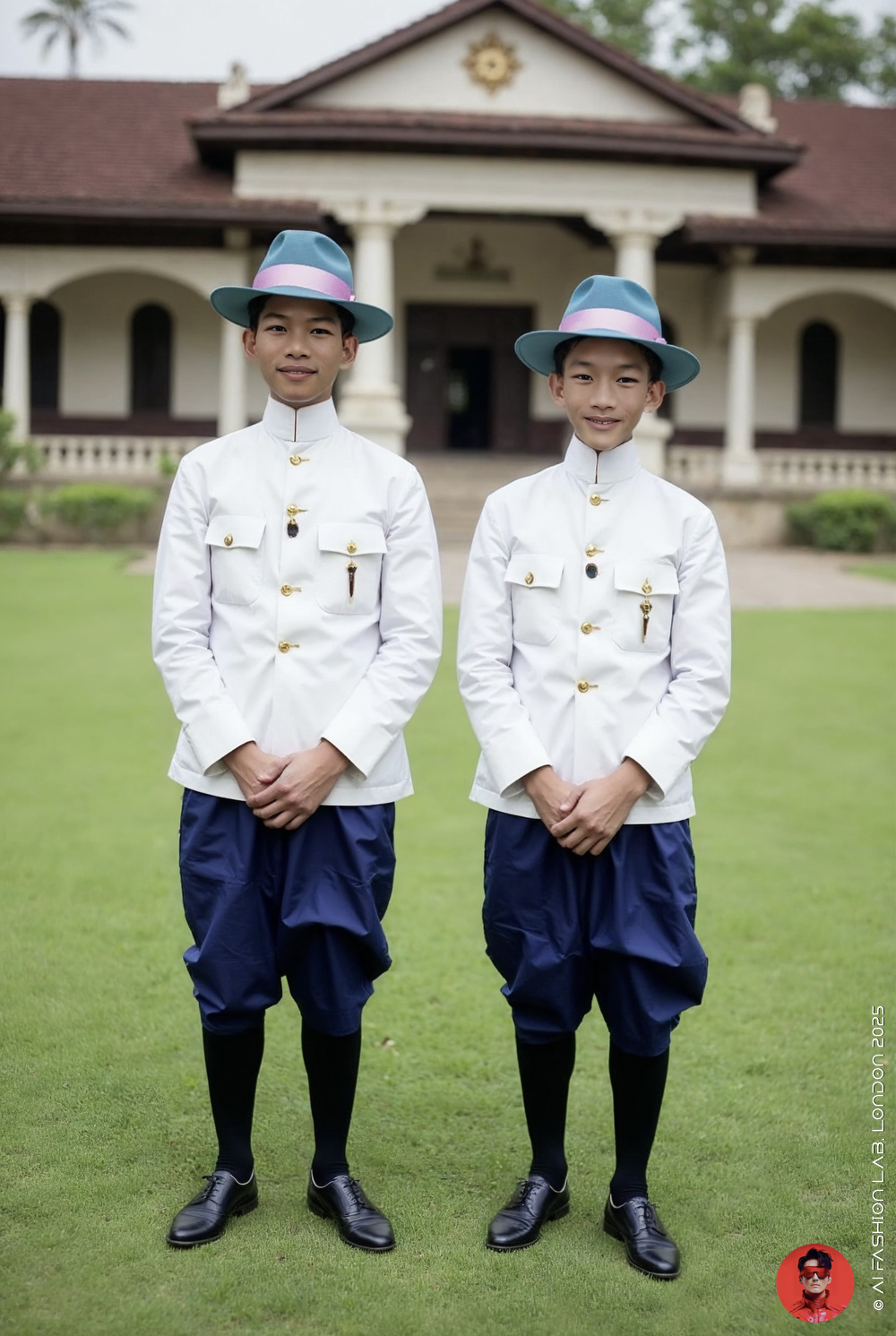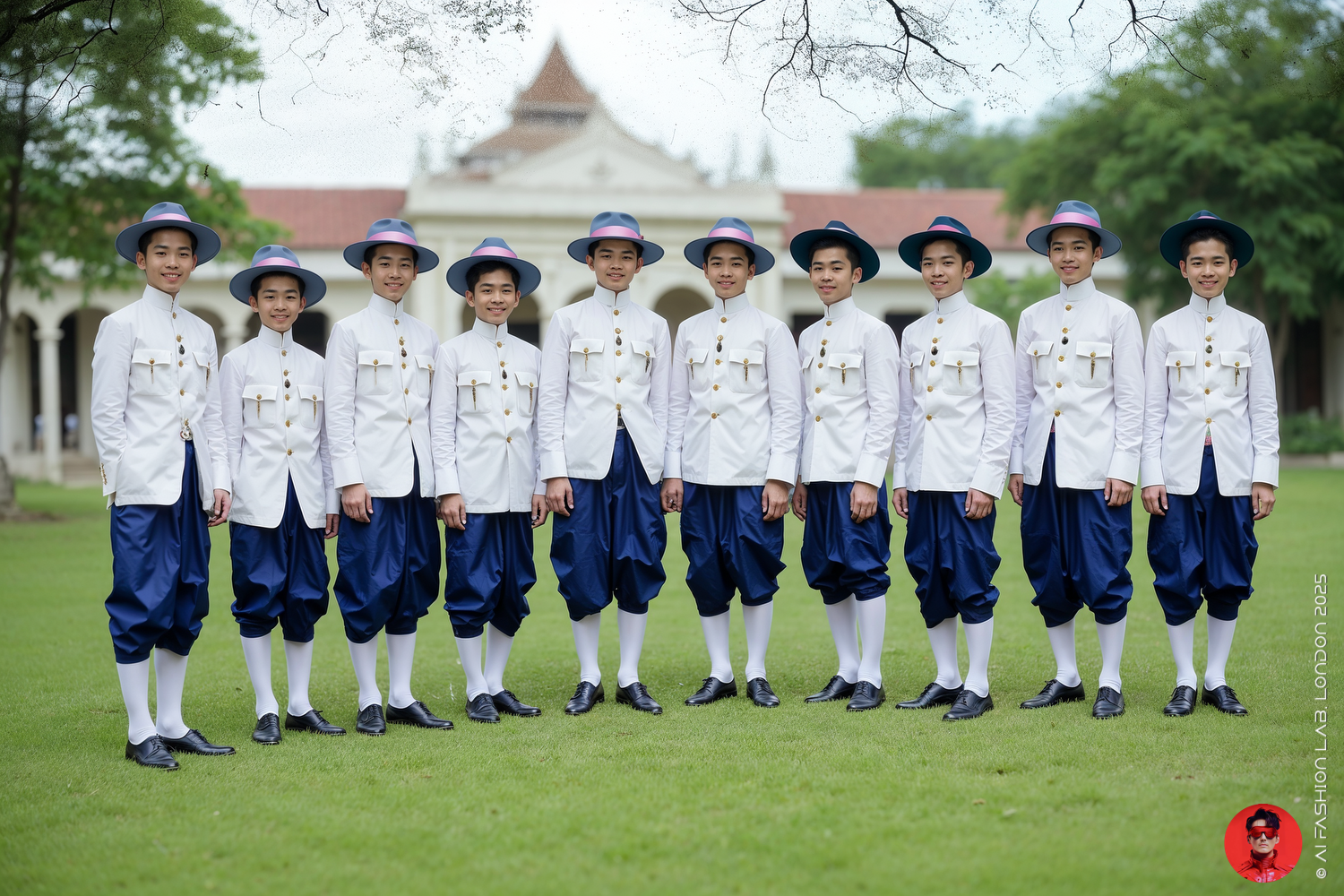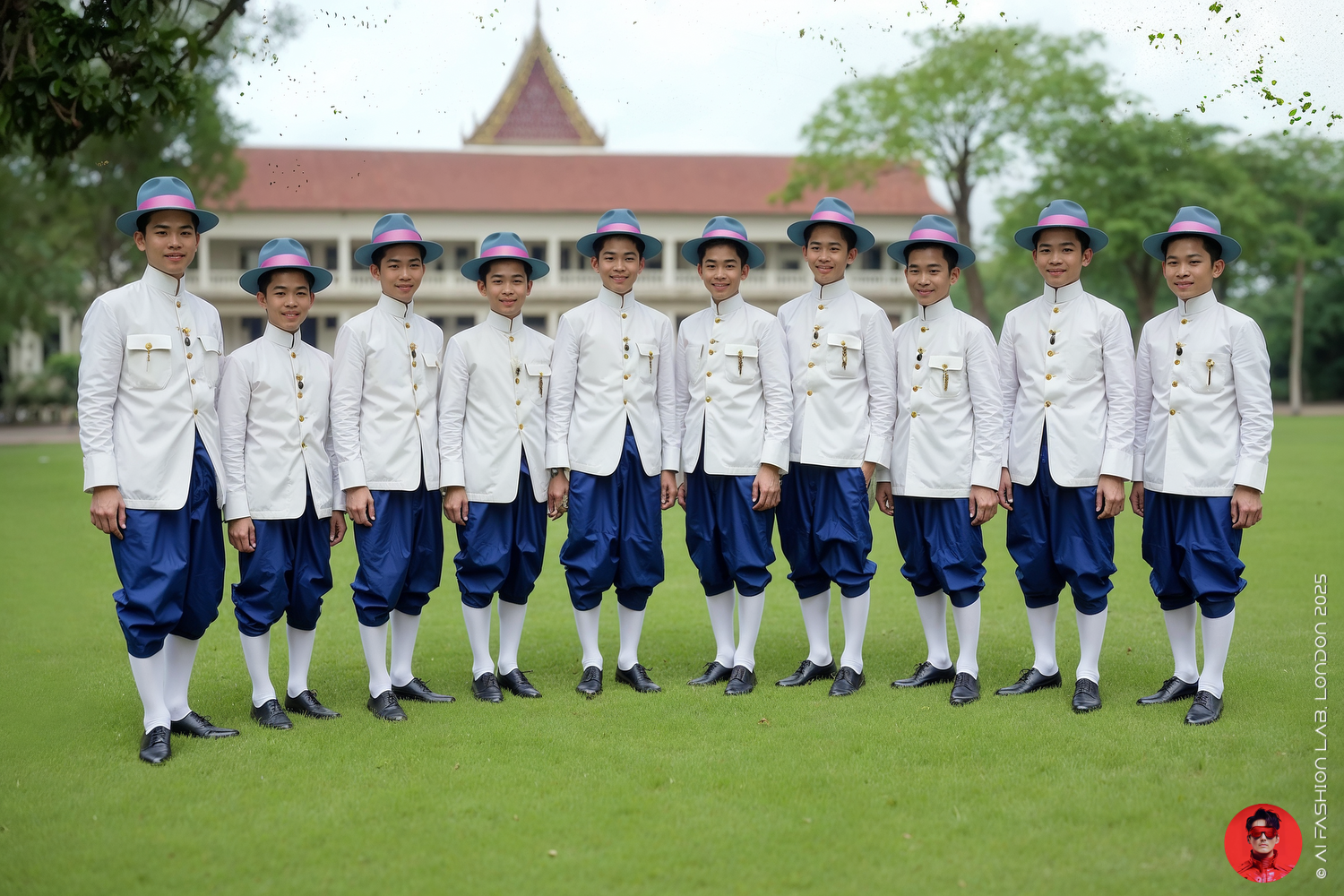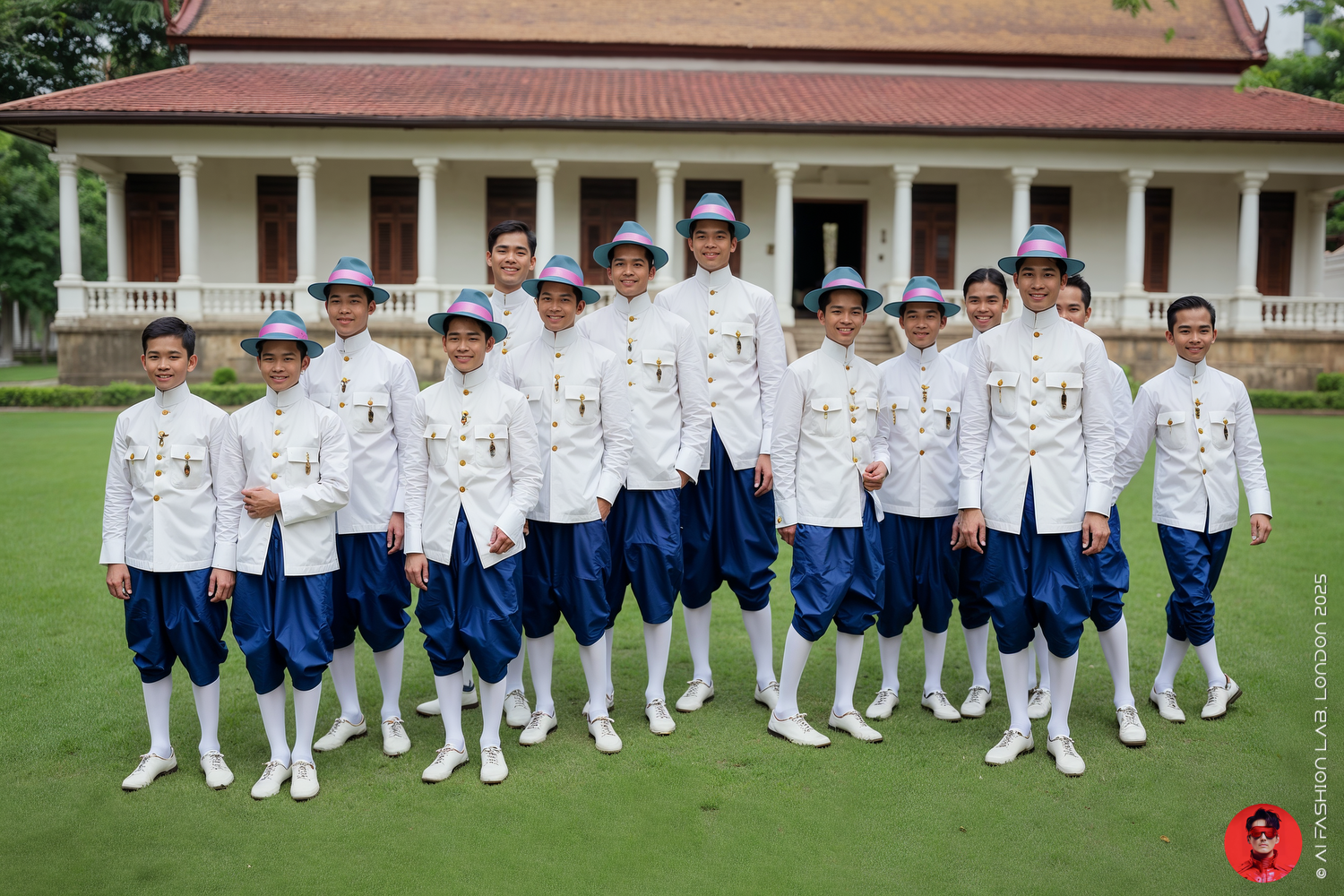เครื่องแบบนักเรียนโรงเรียนราชวิทยาลัยแห่งกรุงสยาม – สมัยสายสวลี ยุคปลายรัชกาลที่ ๕
เครื่องแบบนักเรียนโรงเรียนราชวิทยาลัยแห่งกรุงสยาม – สมัยสายสวลี ยุคปลายรัชกาลที่ ๕
ภาพที่สร้างสรรค์ด้วย AI ชุดนี้จัดทำขึ้นเพื่อเป็นงานจิตอาสาสาธารณะ โดยมีวัตถุประสงค์เพื่ออนุรักษ์และถ่ายทอดภาพความทรงจำในยุครุ่งเรืองของโรงเรียนราชวิทยาลัย (King’s College) ซึ่งได้รับการสถาปนาขึ้นอีกครั้ง ณ สายสวลีสัณฐาคาร ในพระราชูปถัมภ์ของพระบาทสมเด็จพระจุลจอมเกล้าเจ้าอยู่หัว เมื่อวันที่ ๒๓ พฤษภาคม พุทธศักราช ๒๔๔๗
ในการนี้ พระองค์ทรงพระกรุณาโปรดเกล้าฯ ให้ใช้สถานที่ของ พระวิมาดาเธอ พระองค์เจ้าสายสวลีภิรมย์ กรมพระสุทธาสินีนาฏ ปิยมหาราชปดิวรัดา ซึ่งเป็นอาคารโรงเลี้ยงเด็ก ตำบลโรงเลี้ยงเด็ก ถนนบำรุงเมือง จังหวัดพระนคร เป็นที่ตั้งของโรงเรียน โดยเรียกกันในภายหลังว่า "สมัยสายสวลี" ตามชื่ออาคารใหญ่ ตึกสายสวลีสัณฐาคาร ซึ่งใช้เป็นสถานที่เรียน มีเวลาสอนเทอมละ ๔ เดือน และนักเรียนต้องเสียค่าเล่าเรียนเดือนละ ๔๐ บาทต่อคน หลักสูตรการเรียนการสอนในยุคนั้นครอบคลุมทั้งภาษาไทยและภาษาอังกฤษ โดยรับนักเรียนทั้งแบบอยู่ประจำและไป-กลับ
ภาพในชุดนี้ได้รับการออกแบบขึ้นจากข้อมูลของระเบียบเครื่องแต่งกายนักเรียนในสมัยนั้น ประกอบกับความรู้ด้านประวัติศาสตร์แฟชั่น เพื่อจำลองภาพเครื่องแต่งกายของนักเรียนสมัยรัชกาลที่ ๕ ตอนปลาย อย่างสมจริง อาทิ หมวก บอร์ซาลิโน (Borsalino) สีฟ้าประดับด้วยริบบิ้นกรอสเกรนสีชมพูอ่อน เสื้อราชปะแตนสีขาว กระดุมทอง และโจงกระเบนสีกรมท่า ตามระเบียบของโรงเรียนราชวิทยาลัย
ภาพเหล่านี้มุ่งหมายเพื่อร้อยเรียงจินตภาพของ "สมัยสายสวลี" ซึ่งถือเป็นยุคทองแห่งการฟื้นฟูราชวิทยาลัย ภายใต้การอำนวยการของ มิสเตอร์ เอ. ซี. คาร์เตอร์ อดีตพระอาจารย์ถวายพระอักษรในสมเด็จพระบรมโอรสาธิราช (รัชกาลที่ ๖) ผู้วางรากฐานการศึกษาด้วยระบบ Public School ของอังกฤษ ซึ่งเป็นต้นแบบสำคัญในการปลูกฝังระเบียบวินัย ความเป็นผู้นำ และจิตวิญญาณแห่งความจงรักภักดีแก่ศิษย์ราชวิทยาลัย
โรงเรียนราชวิทยาลัยถือกำเนิดขึ้นจากพระราชดำริของพระบาทสมเด็จพระจุลจอมเกล้าเจ้าอยู่หัว ที่ทรงเล็งเห็นถึงความจำเป็นในการสร้างบุคลากรที่มีความรู้ความสามารถ เพื่อรับมือกับความเปลี่ยนแปลงของโลกในยุคแห่งการล่าอาณานิคม นักเรียนในรุ่นแรกส่วนใหญ่เป็นเจ้านายและบุตรหลานข้าราชการระดับสูง ซึ่งภายหลังล้วนมีบทบาทสำคัญในการบริหารราชการแผ่นดิน และธำรงไว้ซึ่งเอกราชของชาติ
การจัดทำภาพชุดนี้เกิดขึ้นจากการสนทนากับ คุณวิญญูชนก แก้วนอก (ราชวิทย์ รุ่น ๑๖) นายทะเบียนสมาคมศิษย์เก่าราชวิทยาลัย และผู้จัดทำหอประวัติโรงเรียน ภ.ป.ร. ราชวิทยาลัยฯ ผมจึงอาสานำความรู้ด้านประวัติศาสตร์แฟชั่น และการอนุรักษ์เครื่องแต่งกาย มาผสานกับศักยภาพของเทคโนโลยี AI เพื่อสร้างสรรค์ภาพประวัติศาสตร์จำลองเหล่านี้ให้มีความเที่ยงตรงทั้งในด้านเครื่องแต่งกาย และบริบททางวัฒนธรรมของยุคสมัย
ผมขอมอบภาพชุดนี้แด่ศิษย์เก่า คณาจารย์ นักเรียน และผู้สนใจทุกท่าน ในฐานะสื่อกลางในการเชื่อมโยงอดีตและปัจจุบัน เพื่อจุดประกายความตระหนักรู้ในคุณูปการของราชวิทยาลัย และสืบสานแรงบันดาลใจแห่งการเรียนรู้จากสถาบันการศึกษาที่ทรงคุณค่าแห่งนี้
Siam’s King’s College Uniforms – Saisavali Era, Late Reign of King Chulalongkorn
A Historical Imagery Collection Reimagined through Artificial Intelligence
This image collection was created as a public-spirited initiative, with the aim of preserving and presenting the memory of King’s College (Ratchawitthayalai) during one of its most significant periods of revival. The school was re-established on 23 May 1904 (B.E. 2447) by royal command of His Majesty King Chulalongkorn (Rama V), and relocated to Saisavali Sathanthakarn, the former royal nursery of H.R.H. Princess Saisavali Bhiromya, Princess of Sudhasininat Piyamaharaj Padivaradda. This location, situated in the Tambon Rong Liang Dek district on Bamrung Mueang Road, became known as the “Saisavali Era,” named after the main academic building, Saisavali Sathanthakarn Hall.
The school operated with two terms per academic year, each lasting four months. Tuition was 40 baht per month per student. Instruction was provided in both Thai and English, with pupils enrolled as either boarding or day students.
This collection draws upon original student uniform regulations of the time, combined with historical costume research, to reconstruct the appearance of King’s College students in the early 20th century. The visuals showcase key elements such as the Borsalino hat, white cotton raj-pattern tunics with gold buttons, and traditional jong kraben trousers, adhering closely to the official dress code.
The imagery seeks to reawaken the spirit of the “Saisavali Era”—a golden age of the school’s second founding—under the leadership of Mr. A.C. Carter, a British headmaster and former royal tutor to the Crown Prince. Carter introduced a model based on the British Public School system, laying the foundation for discipline, leadership, and loyal service that became hallmarks of King’s College alumni.
The creation of the school was deeply rooted in King Chulalongkorn’s visionary response to colonial encroachment, aiming to develop a new generation of knowledgeable and capable leaders. Most of the school’s early students were princes and sons of high-ranking officials, many of whom went on to serve the country with distinction and played pivotal roles in preserving Siam’s sovereignty.
This collection was made possible through an insightful conversation with Khun Winyuchonok Kaewnok (Rachawit 16), Registrar of the Ratchawitthayalai Alumni Association and curator of the King’s College Historical Archives. Volunteering my expertise in historical fashion research and garment preservation, I integrated the use of artificial intelligence to reconstruct these historical images with care and fidelity—ensuring each image reflects the identity, lifestyle, and historical context of its era.
I humbly dedicate this visual archive to all alumni, educators, students, and heritage enthusiasts, as a bridge between past and present—reinvigorating awareness of King’s College’s noble legacy, and the enduring inspiration that this great institution continues to offer.
#aifashionlab #AI #aiartist #aiart #aifashion #aifashiondesign #aifashionstyling #aifashiondesigner #fashion #fashionhistory #historyoffashion #fashionstyling #fashionphotography #digitalfashion #digitalfashiondesign #digitalcostumedesign #digitaldesign #digitalaiart #ThaiFashionHistory #ThaiFashionAI


